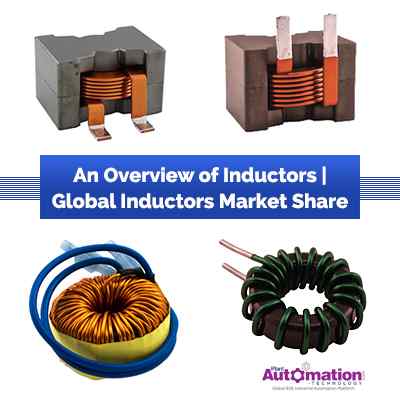An Overview of Inductors | Types, Applications & Global Inductors Market Share

Inductors deal with voltage and current where an inductor measures change in current based on the voltage applied to it. The current rises when the voltage is laid across an inductor.
An inductor stores energy in a magnetic field when electric current flows through it. On the other hand, it is a passive two-terminal electrical component. An inductor typically consists of an insulated wire wound into a coil around a core.
To measure inductance i.e. the capability of an inductor to store energy, the relationship between the voltage applied to the inductor and the increase in current it causes needs to be evaluated.
If the inductor contains the greater number of coils, the inductance will also be greater. In general, coils with iron cores have greater inductance than non-magnetic or air cores.
A wide variety of results can be achieved for specific applications using several different kinds of coils.
The magnetic flux within the coil is Φ = µNAl i where N is the number of turns, A is the cross-sectional area of the coil and l is the length of the coil (around the toroid). µ is a property of the material that the core is made from and is called its permeability. For free space (or air): µ0 = 4π × 10−7 = 1.26 µH/m, for steel, µ ≈ 4000 µ0 = 5 mH/m.
How Do Inductors Work?
As with capacitors, Inductors react differently to both DC (direct current) and AC (Alternating Current) circuits.
Inductors and DC
If a DC signal passes through an inductor, it creates a magnetic field around the inductor. This magnetic field can be used for various functions.
As the coil of the relay is energized by a DC signal, the magnetic field generated by the inductor changes the state of the relay from an Open to a Closed state. This is the fundamental principle behind most electromagnetic switches (relays).
Inductors and AC
If an AC signal is introduced to an inductor, it tries to create a magnetic field. However, as AC signals change from positive (+) to negative (-), the magnetic field around the inductors changes in state.
This change in magnetism, or Magnetic Flux creates an effect called INDUCTANCE. On the other hand, the inductive property of an inductor is determined by the gauge of wire and number of windings in the inductor.
Types of Inductors
There are a wide range of inductors available based on sizes and ratings. Inductors are used in electronics and in wider application areas such as noise elimination, voltage stabilization, signal controlling, power electronic equipments, automobile operations etc.
Here are the types of inductors:
a) Coupled Inductors
Coupled Inductors exhibit magnetic flux that depends on their linked other conductors. Coupled inductors are often used when mutual inductance is needed.
For instance, a transformer is one type of coupled inductor as it is used to step up or step down voltage.
b) Multi-Layer Inductors
Multi-layer inductors consists of a layered coil, wound multiple times around the core. These inductors have a high inductance level as they have multiple layers, insulation between them.
If additional layers of coiled wire are added to an inductor, inductance will be increases besides capacitance between the wires.
c) Molded Inductors
Molded inductors are molded using plastic or ceramic insulation. They are often used in circuit boards.
d) Power Inductors
Power inductors are available in various form factors and power levels from surface mount inductors.
Large magnetic fields are created, with the amount of current that power inductors are often subjected to.
e) Ceramic Core Inductors
Ceramic core inductors have a dielectric ceramic core i.e. it cannot store a lot of energy but has very low twist and hysteresis.
f) Chokes
Choke is an inductor that is designed to block high frequency pulses while allowing lower frequency pulse through. Choking off or blocking of high-frequency signals is possible with these inductors, hence the name.
To reduce parasitic capacitance and to operate effectively, RF chokes use iron powder or ferrite beads combined with complex winding patterns.
Types of Inductor Cores
In the performance of an inductor, core material plays a key role as it directly impacts the inductance of the inductor.
The types of inductor cores include:
Air cores have higher frequency operation due to no core losses but a lower inductance.
Iron cores have low resistance with high inductance.
Ferrite cores have non-conductive ceramic material for higher frequency operation. Magnetic saturation limits the current capacity
Toroidal cores are cores shaped like donuts that reduce radiated EMI and provide high inductance.
Laminated cores have high inductance with lower hysteresis and eddy current losses.
Applications of Inductors:
Inductors are used for various purposes based on the requirements:
- They can be used in tuning circuits
- These are used as sensors
- Inductors are used to store energy in a device
- Inductors are used in induction motors
- They are used as transformers
- Inductors are used as filters
- They are used as ferrite beds
The Global Inductor Market
The global inductor market is valued at US$4364.52 million in 2018 and is expected to reach a value of USD 5411.12 million by 2024, at a CAGR of 3.73% over the forecast period (2019-2024).
There has been a steady growth in the growth of the inductor market, owing to the increasing number of product launches and developments in various sectors.
This has raised demand for passive electronic components, growing use of inductors in automotive electronics, and increasing adoption of smart grids.
Globally, the growing demand for consumer electronics, such as smartphones, tablets, portable gaming consoles, laptops, set-top boxes, and others, is the major factor that is driving the demand for various inductors.
Inductors market is gaining a boost from high reliability and rugged applications in the industrial, aerospace & defense, and medical sectors.











